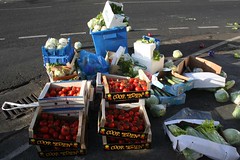One thing that kept me bothering from the moment I first visited a temple here in the US is....temple architecture. Temples here remain more or less archaic with one exception: the fire-alarms and sprinklers on top. They are an excellent illustration of "post-industrial vedic society with retrograde-est things possible" phenomenon. Like in any culture, for a long time, temples were places of public gathering in India, not any more though. Apart from the usual architectural differences between temples of North and South India, one significant difference is ventilation. Tropics made temples of South India more ventilated, while colder weathers up north made them less naturally ventilated.
Temples here have a similar story. Climate and Air-conditioning make them close walled. Temples are THE places of gathering for Desis, grocery stores being a close-second. Some guy said he is looking for a job and put up his resume on a temple notice board in San Jose! From 'Camry for sale' to furniture to music classes to India tickets to SP Balasubramanyam's benefit show to a local desi DJ party .....everything ends up on a temple notice board. Temples have been embracing enough in these instances.
But why do they have to look exactly like the ones built by Raja Raja Chola or Krishna Deva Raya?? Why do they have to the same ornamentation on walls and the roof invented centuries ago? The only innovation I can appreciate is...coloring the ornamentation... as done on the outer gopurams of the Meenakshi temple in Madurai even though it may sound a little cheesy and non-traditional (non-vaidika) for many brahmins. Oh, wait! How can I forget this great innovation? The
Saraswathi temple in Pilani (home to BITS Pilani) is modelled after one of those exotic Khajuraho temples. But the high point is when you notice the busts of Lincoln, Ramanujan, Vivekananda, Paramahamsa, Pasteur, Einstein, Tagore and other 'kids of Saraswathi' on its white marble walls. Thats
some re-interpretation of Saraswathi, I thought. GD Birla was truly a visionary. (Well, I've to admit that I went to school there. But even with out those allegiances, I' would admit that Saraswathi Mandir is quite something).
Now, here is a country that is the home to some of the greatest modern architects on the planet: Lloyd Wright, Frank Gehry, Louis Kahn and Maya Linn ( I choose these people in this context... as these are the guys who have an outstanding sense of blending with nature, flowing shapes, natural ventilation and a sense of time). The 'model minority' of the nation with all its wealth, advanced degrees and progressiveness goes to temples frozen in 15th century! The low point was the Swaminarayan temple in Chicago. Tonnes of money were spent on the temple, tonnes of marble was mined from God knows where. There is an elaborate tour of 'Sanatana Dharma' along the entrance. But I felt extremely claustrophobic when I stepped into the actual temple. Its like a dungeon with little sun light coming in. They only got more money to spend on 'disco lighting'. I couldnt avoid drawing comparisons to the
cave paintings of France. The only difference, the visitors here are not high on narcotics.
The other extreme was a small time temple in Artesia, near Los Angeles. A church in a neighborhood which recently became 'Little India' ...was converted to a temple. The temple didnt have any inner sanctum and a formal priest. It didnt have a shoe stand, it had a coat closet and rows of seating. But was I comfortable with the whole thing? Not completely. I didn't find it original enough. It was too practical ( :D ). It was too much of change. It was not building on any of the existing 'culture' nurtured and matured through centuries of time.
But I believe there is a middle ground. I believe there has to be an evolution. An evolution from those 15th century architectural approaches to something more modern but at the same time retaining the core philosophy of the traditional approach. Chola's
Brihadeeswaralaaya is state-of-the-art because, at that time it was higher than anything around it. It took some innovative engineering techniques to build temples using massive amounts of rock. It held people in awe. I am not sure if taking a 15th century approach to constructing a temple today has the same effect.
The mere fact that these temples are in the United States, somehow raises my expectations a lot. In this country, there can be a Vegas kind of extravagance, a bible belt kind of conservatism but there will be and should be a religious equivalent of Maya Lin's contemplative
Vietnam War Memorial.



